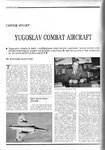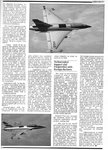imalko
Chief Master Sergeant
FOREWORD
The promising plane that never flew - that is in short the story of this aircraft. Known as YU-supersonic or NA (in translation Novi avion=new aircraft) this project was started in mid 1980s and intended to make former Yugoslavia capable to produce its own high tech air superiority fighter jets. If materialized this would made Yugoslavia completely self-sufficient in manufacturing all types of military equipment and modern conventional weapon systems. Series production of 150 examples for Yugoslav AF was planned and export to other interested countries was also expected. Due to the desintegration of Yugoslavia this never happened and project was canceled. At the time of cancellation the project was at an advanced stage with many components for building a prototype already completed. Maiden flight of the first prototype was planned for 1992.
I thought it would be interesting to share story of this aircraft with you guys, so here's the translated (and edited) version of some materials I've found on NA project. These were originally posted on another forum in PDF format in Serbian language and under title "Yugoslav combat supersonic aircraft - extract from development program, Basic data, January 1983".
For more info and few pictures you can check out also Wikipedia page. Text is in Serbian language I'm afraid, but you can use automatic translation to English. Though this feature has its limitations I hope it will be useful enough.
Here's the link: Google Translate
MULTIROLE COMBAT SUPERSONIC AIRCRAFT "NA"
An indigenous Yugoslav design proposed in mid 1980's, "NA" was envisioned as a 4th generation multirole supersonic combat jet aircraft intended for air support, defense of national airspace and reconnaissance, capable to operate in all weather conditions and at night.
High performance of "NA" were to be ensured with aerodinamic delta-canard configuration, automatic deflection of wing's leading and trailing edges and fly-by-wire flight controls. Special care was taken to achieving high performance in transonic flight. High maximum speed was expected to be achieved despite the fixed geometry air intake.
Aircraft structure was to be build with modern materials and composit materials for certain structural elements were also considered. Tricicle type landing gear was planned for operative use from concrete strips, with main landing gear retracting into the wing and nose wheel retracting rearwards into the fuselage beneath air intake.
Aircraft was to be equipped with low-bypass turbofan jet engine of the latest generation, providing about 95kN trust with afterburner. Air intake, located beneath the fuselage was to be of fixed geometry type ensuring good work of the engine at all flight regimes. (Note: When project "NA" was originally commenced the first solution was to locate air intake below the fuselage, which was inspired with F-16 and Lavi projects. Later during development process, when French Dassault joined the project providing technical support this was changed and air intakes were relocated, which, coupled with changes in the wings etc, gave the "NA" appearance of the one engined Raffale as seen on the picture in the attachment below).
Cockpit was anatomically adapted to the pilot providing excellent visibility in all directions. Instrument panel was incorporated with integrated displays (head-up and head-down). Ejector seat was type "zero-zero".
The "NA" was intended to be capable of carrying wide variety of ordnance - cannons, bombs, rockets (guided with modern attack-navigational system), auxiliary drop tanks, additional equipment and devices. Standard armament consisted of two-barrel cannon with 300 grenades and two IC rockets on wingtips. Maximum weapons load was 5000kg carried on five hard points beneath wings and fuselage.
Attack-navigational system includes multifunctional radar capable of operating in air-to-air and air-to-ground modes and with laser targeting system enables low level penetration. Advanced cockpit displays are incorporated and great care was taken to ensure secure communications, protection from electronic interference and jamming.
The promising plane that never flew - that is in short the story of this aircraft. Known as YU-supersonic or NA (in translation Novi avion=new aircraft) this project was started in mid 1980s and intended to make former Yugoslavia capable to produce its own high tech air superiority fighter jets. If materialized this would made Yugoslavia completely self-sufficient in manufacturing all types of military equipment and modern conventional weapon systems. Series production of 150 examples for Yugoslav AF was planned and export to other interested countries was also expected. Due to the desintegration of Yugoslavia this never happened and project was canceled. At the time of cancellation the project was at an advanced stage with many components for building a prototype already completed. Maiden flight of the first prototype was planned for 1992.
I thought it would be interesting to share story of this aircraft with you guys, so here's the translated (and edited) version of some materials I've found on NA project. These were originally posted on another forum in PDF format in Serbian language and under title "Yugoslav combat supersonic aircraft - extract from development program, Basic data, January 1983".
For more info and few pictures you can check out also Wikipedia page. Text is in Serbian language I'm afraid, but you can use automatic translation to English. Though this feature has its limitations I hope it will be useful enough.
Here's the link: Google Translate
MULTIROLE COMBAT SUPERSONIC AIRCRAFT "NA"
An indigenous Yugoslav design proposed in mid 1980's, "NA" was envisioned as a 4th generation multirole supersonic combat jet aircraft intended for air support, defense of national airspace and reconnaissance, capable to operate in all weather conditions and at night.
High performance of "NA" were to be ensured with aerodinamic delta-canard configuration, automatic deflection of wing's leading and trailing edges and fly-by-wire flight controls. Special care was taken to achieving high performance in transonic flight. High maximum speed was expected to be achieved despite the fixed geometry air intake.
Aircraft structure was to be build with modern materials and composit materials for certain structural elements were also considered. Tricicle type landing gear was planned for operative use from concrete strips, with main landing gear retracting into the wing and nose wheel retracting rearwards into the fuselage beneath air intake.
Aircraft was to be equipped with low-bypass turbofan jet engine of the latest generation, providing about 95kN trust with afterburner. Air intake, located beneath the fuselage was to be of fixed geometry type ensuring good work of the engine at all flight regimes. (Note: When project "NA" was originally commenced the first solution was to locate air intake below the fuselage, which was inspired with F-16 and Lavi projects. Later during development process, when French Dassault joined the project providing technical support this was changed and air intakes were relocated, which, coupled with changes in the wings etc, gave the "NA" appearance of the one engined Raffale as seen on the picture in the attachment below).
Cockpit was anatomically adapted to the pilot providing excellent visibility in all directions. Instrument panel was incorporated with integrated displays (head-up and head-down). Ejector seat was type "zero-zero".
The "NA" was intended to be capable of carrying wide variety of ordnance - cannons, bombs, rockets (guided with modern attack-navigational system), auxiliary drop tanks, additional equipment and devices. Standard armament consisted of two-barrel cannon with 300 grenades and two IC rockets on wingtips. Maximum weapons load was 5000kg carried on five hard points beneath wings and fuselage.
Attack-navigational system includes multifunctional radar capable of operating in air-to-air and air-to-ground modes and with laser targeting system enables low level penetration. Advanced cockpit displays are incorporated and great care was taken to ensure secure communications, protection from electronic interference and jamming.
Attachments
Last edited:




